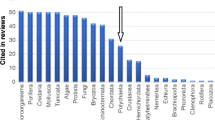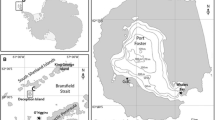Abstract
Holothuroids produce triterpenoid saponins that act as chemical defenses against predators and parasites. These saponins interact with sterols of the plasma membranes, inducing the formation of pores and then cell lysis. To avoid such harms from their own saponins, holothuroids present specific sterols in their tissues. Despite the noxious cytotoxic effect of their chemical defenses, holothuroids host various associates that display specific adaptations to resist to saponin toxicity. Among them, symbiotic carapid fishes (i.e., pearlfishes) are resistant to ichthyotoxic saponins as they display no stress response and a survival time 45 times longer than free-living fishes without any specific gill adaptation. The present study aims at discovering the resistance mechanism(s) developed by carapids by addressing 3 hypotheses: carapids have (1) a mechanical barrier against the toxin constituted by a larger secretion of mucus than other fishes, (2) a bioactive barrier against the toxins constituted by a mucus effective on saponins and (3) a Δ7sterol tissue composition mimicking holothuroids that enable them to resist to saponins. First experiments showed that the mucus has no effective impact on saponin chemical structures. Mass spectrometry analyses showed that carapids, similarly to non-symbiotic fishes but contrary to their hosts, present a Δ5sterol tissue composition. However, two different procedures have shown that carapids produce six to ten times more mucus than control fishes, suggesting that a great quantity of mucus can protect carapids from their host’s saponins and acts as a mechanical barrier against toxins. Therefore, these results provide a new understanding of the carapids–holothuroids relationship.







Similar content being viewed by others
References
Althunibat OY, Bin Hashim R, Taher M et al (2009) In vitro antioxidant and antiproliferative activities of three Malaysian sea cucumber species. Eur J Sci Res 37:376–387
Armah CN, Mackie AR, Roy C et al (1999) The Membrane-permeabilizing effect of avenacin A-1 involves the reorganization of bilayer cholesterol. Biophys J 76:281–290. doi:10.1016/S0006-3495(99)77196-1
Augustin JM, Kuzina V, Andersen SB, Bak S (2011) Molecular activities, biosynthesis and evolution of triterpenoid saponins. Phytochemistry 72:435–457. doi:10.1016/j.phytochem.2011.01.015
Bader G, Hiller K (1987) Neue Ergebnisse zur Struktur und Wirkungsweise von Triterpensaponinen. Pharmazie 42:577–597
Bakus GJ (1968) Defensive mechanisms and ecology of some tropical holothurians. Mar Biol 2:23–32. doi:10.1007/BF00351634
Ballantine JA, Lavis A, Morris RJ (1981) Marine sterols. XV. Sterols of some oceanic holothurians. J Exp Mar Bio Ecol 53:89–103. doi:10.1016/0022-0981(81)90086-1
Barwick VJ (1999) Sources of uncertainty in gas chromatography and high-performance liquid chromatography. J Chromatogr A 849:13–33
Benndorf J (1987) Predation. Direct and Indirect Impacts on Aquatic Communities. University Press of New England
Brooks CJW, Horning EC, Young JS (1968) Characterization of sterols by gas chromatography-mass spectrometry of the trimethylsilyl ethers. Lipids 3:391–402. doi:10.1007/BF02531277
Burnell DJ, Apsimon JW (1983) Echinoderm Saponins. In: Marine natural products: chemical and biological perspectives. Academic Press Inc., pp 287–379
Castro-Aguirre JL, Garcia-Dominguez F, Balart EF (1996) Nuevos hospederos y datos morfometricos de Encheliophis dubius (Ophidiiformes: Carapidae) en el Golfo de Californica, Mexico. Rev Biol Trop 44:753–756
Caulier G, Flammang P, Rakotorisoa P et al (2013) Preservation of the bioactive saponins of Holothuria scabra through the processing of trepang. Cah Biol Mar 54:685–690
Cimino G, Ghiselin T (2001) Marine natural products chemistry as an evolutionary narrative. In: McClintock JB, Baker BJ (eds) Marine chemical ecology. CRC Press, Boca Raton, pp 115–154
Cone RA (2009) Barrier properties of mucus. Adv Drug Deliv Rev 61:75–85. doi:10.1016/j.addr.2008.09.008
Demeyer M, De Winter J, Caulier G et al (2014) Molecular diversity and body distribution of saponins in the sea star Asterias rubens by mass spectrometry. Comp Biochem Physiol Part B Biochem Mol Biol 168:1–11. doi:10.1016/j.cbpb.2013.10.004
Demeyer M, Wisztorski M, Decroo C et al (2015) Inter- and intra-organ spatial distributions of sea star saponins by MALDI imaging. Anal Bioanal Chem. doi:10.1007/s00216-015-9044-0
Drazen JC, Phleger CF, Guest MA, Nichols PD (2008) Lipid, sterols and fatty acid composition of abyssal holothurians and ophiuroids from the North-East Pacific Ocean: food web implications. Comp Biochem Physiol Part B Biochem Mol Biol 151:79–87. doi:10.1016/j.cbpb.2008.05.013
Eeckhaut I, Caulier G, Brasseur L et al (2015) Effects of holothuroid ichtyotoxic saponins on the gills of free-living fishes and symbiotic pearlfishes. Biol Bull 228:253–265
Emery DC (1880) Fierasfer. Studî intorno alla sistematica, l’anatomia e la biologia delle specie mediterranee di questo digenere. Roma
Flammang P (2002) Biomechanics of adhesion in sea cucumber Cuvierian tubules (Echinodermata, Holothuroidea). Integr Comp Biol 42:1107–1115. doi:10.1093/icb/42.6.1107
Francis G, Kerem Z, Makkar HPS, Becker K (2002) The biological action of saponins in animal systems: a review. Br J Nutr 88:587. doi:10.1079/BJN2002725
Glauert AM, Dingle JT, Lucy JA (1962) Action of saponin on biological cell membranes. Nature 196:953–955. doi:10.1038/196953a0
Goad LJ (1983) Steroid biochemistry of marine invertebrates. Mar Chem 12:225. doi:10.1016/0304-4203(83)90087-7
Goad LJ, Akihisa T (1997) Analysis of sterols, 6th edn. Blackie Academic & Professional, London
Goad LJ, Rubinstein I, Smith AG (1972) The sterols of echinoderms. Proc R Soc B Biol Sci 180:223–246. doi:10.1098/rspb.1972.0016
Ida H, Sano M, Kawashima T, Yasuda F (1977) New records of a pomacentrid fish, Dascyllus melanurus and Cirrhitid Fish, Paracirrhites hemistictus from Japanese Waters. Jpn J Ichthyol 24:213–217
Jangoux M (1984) Diseases of echinoderms. Helgolander meeresunters 37:207–216
Kalinin VI, Prokofieva NG, Likhatskaya GN et al (1996) Hemolytic activities of triterpene glycosides from the holothurian order dendrochirotida: some trends in the evolution of this group of toxins. Toxicon 34:475–483. doi:10.1016/0041-0101(95)00142-5
Kicha AA, Ivanchina NV, Gorshkova IA et al (2001) The distribution of free sterols, polyhydroxysteroids and steroid glycosides in various body components of the starfish Patiria (= Asterina) pectinifera. Comp Biochem Physiol Part B Biochem Mol Biol 128:43–52. doi:10.1016/S1096-4959(00)00317-1
Knights BA (1967) Identification of plant sterols using combined GLC/Mass spectrometry. J Chromatogr Sci 5:273–282
Kofler L (1927) Die saponine. Springer Vienna, Vienna
Li R, Zhou Y, Wu Z, Ding L (2006) ESI-QqTOF-MS/MS and APCI-IT-MS/MS analysis of steroid saponins from the rhizomes of Dioscorea panthaica. J Mass Spectrom 41:1–22. doi:10.1002/jms.988
Machida Y (1989) New distribution records of the pearlfish, Carapus mourlani, with notes on its morphometry. Jpn J Ichthyol 36:363–368. doi:10.1007/F02905622
Mackie AM, Singh HT, Owen JM (1977) Studies on the distribution, biosynthesis and function of steroidal saponins in echinoderms. Comp Biochem Physiol Part B Comp Biochem 56:9–14. doi:10.1016/0305-0491(77)90214-0
Maier MS (2008) Biological activities of sulfated glycosides from echinoderms. Bioact Nat Prod 35:311–354. doi:10.1016/S1572-5995(08)80008-7
Markle DF, Olney JE (1990) Systematics of the pearlfishes (Pisces:carapidae). Bull Mar Sci 47:269–410
Meyer-Rochow VB (1977) Comparison between 15 Carapus mourlani in a Single Holothurian and 19 C. mourlani from Starfish. Copeia 1977:582. doi:10.2307/1443286
Meyer-Rochow VB (1979) Stomach and gut contents of Carapus mourlani from starfish and a holothurian. Ann Zool Fenn 16:287–289
Moreau RA, Whitaker BD, Hicks KB (2002) Phytosterols, phytostanols, and their conjugates in foods: structural diversity, quantitative analysis, and health-promoting uses. Prog Lipid Res 41:457–500. doi:10.1016/S0163-7827(02)00006-1
Morris RJ, Ballantine JA, Roberts JC, Lavis A (1982) The sterols of some marine teleosts. Comp Biochem Physiol Part B Comp Biochem 73:481–484. doi:10.1016/0305-0491(82)90063-3
Nigrelli RF (1952) The effect of holothurin on fish, and mice with sarcoma 180. Zoologica 37:89–90
Paredes-Ríos GA, Balart EF, Paredes-Rios GA (1999) Corroboration of the Bivalve, Pinna rugosa, as a Host of the Pacific Pearlfish, Encheliophis dubius (Ophidiiformes: Carapidae), in the Gulf of California, México. Copeia 1999:521. doi:10.2307/1447503
Parmentier E (2003) Contribution à l’étude des relations entre des poissons de la famille des Carapidae et leurs hôtes invertébrés : une approche multidisciplinaire. University of Liege
Parmentier E, Castillo G, Chardon M, Vandewalle P (2000) Phylogenetic analysis of the pearlfish tribe Carapini (Pisces: Carapidae). Acta Zool 81:293–306
Parmentier E, Vandewalle P (2003) Morphological adaptations of Pearlfish (Carapidae) to their various Habitats. In: Val AL (ed) Fish adaptations. Science Pu, Oxford, pp 261–276
Parmentier E, Vandewalle P (2005) Further insight on carapid holothuroid relationships. Mar Biol 146:455–465. doi:10.1007/s00227-004-1467-7
Ponomarenko LP, Kalinovsky AI, Moiseenko OP, Stonik VA (2001) Free sterols from the holothurians Synapta maculata, Cladolabes bifurcatus and Cucumaria sp. Comp Biochem Physiol Part B Biochem Mol Biol 128:53–62. doi:10.1016/S1096-4959(00)00318-3
Popov AA, Kalinovskaia NI, Kuznetsova TA et al (1983) Role of sterols in the membranotropic activity of triterpene glycosides. Antibiotiki 28:656–659
Shen SC, Yeh HS (1987) Study on pearlfishes (Ophidiiformes : Carapidae) of Taiwan. J Taiwan Museum 40:45–56
Shubina LK, Fedorov SN, Levina EV et al (1998) Comparative study on polyhydroxylated steroids from echinoderms. Comp Biochem Physiol Part B Biochem Mol Biol 119:505–511. doi:10.1016/S0305-0491(98)00011-X
Smith CL (1964) Some pearlfishes from Guam, with notes on their ecology. Pacific Sci 18:34–40
Smith CL, Tyler JC (1969) Observations on the commensal relationship of the Western Atlantic Pearlfish, Carapus bermudensis, and Holothurians. Copeia 1969:206. doi:10.2307/1441726
Smith AG, Rubinstein I, Goad LJ (1973) The sterols of the echinoderm Asterias rubens. Biochem J 135:443–455
Stonik VA, Ponomarenko LP, Makarieva TN et al (1998) Free sterol compositions from the sea cucumbers Pseudostichopus trachus, Holothuria (Microtele) nobilis, Holothuria scabra, Trochostoma orientale and Bathyplotes natans. Comp Biochem Physiol Part B Biochem Mol Biol 120:337–347. doi:10.1016/S0305-0491(98)10023-8
Stonik A, Kalinin VI, Avilov SA (1999) Toxins from sea cucumbers (holothuroids): chemical structures, properties, taxonomic distribution, biosynthesis and evolution. J Nat Toxins 8:235–248
Trott LB (1970) Contribution of the biology of carapid fishes (Paracanthopterygian: Gadiformes). Univ Calif Publ Zool 89:1–41
Trott LB, Chan WL (1972) Carapus homei commensal in the mantle cavity of Tricadna sp. in the South China Sea. Copeia 872–873
Trott LB, Trott EB (1972) Pearlfishes (Carapidae: Gadiforme) collected from Puerto Galera, Minobra, Philippines. Copeia 839–843
Tsutsui S, Komatsu Y, Sugiura T et al (2011) A unique epidermal mucus lectin identified from catfish (Silurus asotus): first evidence of intelectin in fish skin slime. J Biochem 150:501–514. doi:10.1093/jb/mvr085
Tyler JC, Bohlke JE (1972) Records of sponge-dwelling fishes, primary of the Caribbean. Bull Mar Sci 22:601–642
Van Dyck S, Gerbaux P, Flammang P (2009) Elucidation of molecular diversity and body distribution of saponins in the sea cucumber Holothuria forskali (Echinodermata) by mass spectrometry. Comp Biochem Physiol Part B Biochem Mol Biol 152:124–134. doi:10.1016/j.cbpb.2008.10.011
Vanderplanck M, Michez D, Vancraenenbroeck S, Lognay G (2011) Micro-quantitative method for analysis of sterol levels in honeybees and their pollen loads. Anal Lett 44:1807–1820. doi:10.1080/00032719.2010.526271
Vanderplanck M, Moerman R, Rasmont P et al (2014) How does pollen chemistry impact development and feeding behaviour of polylectic bees? PLoS ONE 9:e86209. doi:10.1371/journal.pone.0086209
Weber M (1913) Die fische der Siboga-expedition. E. J. Brill, Leiden
Xu D, Cui J, Bansal R et al (2009) The ellipsoidal area ratio: an alternative anisotropy index for diffusion tensor imaging. Magn Reson Imaging 27:311–323. doi:10.1016/j.mri.2008.07.018
Yamanouchi T (1955) On the poisonous substance contained in holothurians. Publ Seto Mar Biol Lab 4:183–203
Acknowledgments
The authors thank the IH.SM (Toliara, Madagascar) for having allowed them to carry out their experiments within their institute and M. Todesco for technical assistance. This work was supported by a FRFC project (FNRS, Fonds National de la Recherche Scientifique). This study is a contribution by the Centre Interuniversitaire de Biologie Marine (CIBIM). The UMONS MS Lab is grateful to the FNRS for financial support in the acquisition of the Waters QToF Premier Mass Spectrometer and for continuing support. GC benefited and thanks the fund Leopold III and the grant Agathon de Potter.
Author information
Authors and Affiliations
Corresponding author
Additional information
Responsible Editor: F. Weinberger.
Reviewerd by Undisclosed experts.
Rights and permissions
About this article
Cite this article
Brasseur, L., Parmentier, E., Caulier, G. et al. Mechanisms involved in pearlfish resistance to holothuroid toxins. Mar Biol 163, 129 (2016). https://doi.org/10.1007/s00227-016-2901-3
Received:
Accepted:
Published:
DOI: https://doi.org/10.1007/s00227-016-2901-3




